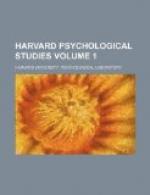object labors under a great disadvantage. And
if there is any force in the claim that diversity
and complexity in an object, with the relatively greater
subjective activity which they imply, tend to hold
the attention to the ideated object about which this
activity is employed, the result could hardly be other
than it is. There can be no question of the presence
of a strong motor element where the object attended
to moves, and where the movement is imaged no less
than the qualities of the object. In fact, the
object and its movement were sometimes sharply distinguished.
According to one subject, ’the image was rather
the image of the motion than of the object moving.’
Again: ’The introspection was disturbed
by the idea of motion; I did not get a clear image
of the moving object; imaged the motion rather than
the object.’ And a subject, who on one
occasion vainly searched the ideational field for
sixty seconds to find an object, reports: ’I
had a feeling of something going up and down, but
no object.’ Clearly an important addition
was made to the active processes implied in the ideation
of a resting object, and it would be singular if this
added activity carried with it no corresponding advantage
in the ideational rivalry. In one case the ideas
of rest and of movement were curiously associated
in the same introspective act. “The figure
which moved,” says the subject, “was imaged
as stationary, and yet the idea of movement was distinctly
present.”
The reports as to the vividness of the rival images
are somewhat conflicting. Sometimes it is the
moving object which was imaged with the more vivid
content, and sometimes the resting object. One
report runs: “The moving object had less
color, but was more distinct in outline than the stationary.”
Sometimes one of the positions of the moving object
was alone represented in the image, either the initial
position (on a level with the resting object) or a
position lower down. On the other hand, we read:
“The image of the moved object seemed at times
a general image that reached clear down, sometimes
like a series of figures, and not very distinct; but
sometimes the series had very distinct outlines.”
In one case (the circle) the image of the figure in
its upper position remained, while the serial repetitions
referred to extended below. This, as might be
supposed, is the report of an exceptionally strong
visualizer. In other cases the object and its
movements were not dissociated: “The moved
object was imaged as moving, and color and outline
were retained.” And again: “Twice
through the series I could see the image of the moving
object as it moved.” “Image of moved
object moved all the time.”
TABLE XV.
1
2 3 4 5
Indiv. Av.
Gray Red Gray
Yellow Gray Green Gray Blue Gray Violet Gray Colored.




